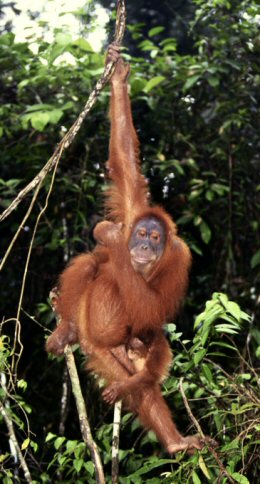4 June 2007
Humans Took First Steps In Tree Tops
by Kate Melville
 Scientists at the University of Liverpool, UK, say that our ability to walk upright developed from foraging for food in forest tree tops and not from walking on all fours (knuckle-walking) on open land. The new theory is quite different from the traditional notion that walking developed slowly after our ancestors moved out of the forests onto the savannahs of East Africa.
Scientists at the University of Liverpool, UK, say that our ability to walk upright developed from foraging for food in forest tree tops and not from walking on all fours (knuckle-walking) on open land. The new theory is quite different from the traditional notion that walking developed slowly after our ancestors moved out of the forests onto the savannahs of East Africa.
Presenting their findings in Science, the researchers contend that knuckle-walking evolved quite recently in chimpanzees and gorillas, as a way of moving on the forest floor, whilst walking on two legs is an older trait and evolved from tree walking.
"The traditional theory of human origins states that we evolved to walk upright from ancestors who walked on all fours when on the forest floor," said Liverpool's Robin Crompton. But he posits that just the opposite may be true, suggesting that; "Upright walking evolved in the ancestors of all apes, including humans, as a means of foraging for food in the small branches of the tropical forests and these techniques were later used by human ancestors to allow them to adapt to walking on two feet on the ground."
To understand why bipedalism (walking on two legs) would be necessary for the tree-living ancestors of humans, the researchers studied the movements of the only completely arboreal great ape, the Sumatran orang-utan, which uses bipedalism to forage for food from small branches of tree tops, and to cross directly from tree top to tree top.
The researchers observed that orang-utans walking bipedally on springy branches act much like athletes running on springy tracks, using extended postures of the knee and hip to give them straighter legs. Additionally, orang-utans use the natural springiness of branches to save energy in movement, particularly when crossing from one tree to another. "Walking upright on two legs, gripping branches with the feet and balancing themselves by holding or touching higher branches with their hands is actually a very effective way of moving on smaller branches," explained Crompton.
The break-up of the East African tropical forests about 15 million years ago (when trees became separated and further apart) was what forced our ancestors to go down to the ground in order to move between trees, suggests the study. "Our ancestors made use of the way they moved through the trees to adapt to their life on the ground. Ancestors of chimps and gorillas, however, tried to maintain access to the canopy as well as the ground by developing very strong arms to climb vertically up and down tree-trunks and as a consequence became 'top-heavy', [moving] predominantly by knuckle-walking," concluded Crompton.
Related articles:
Ancient Man Built For Fighting
Ancient Man Spread The Love Around
Missing Link A Tripping Chimp?
Source: University of Liverpool
